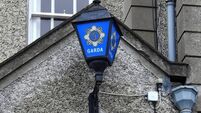Queen shelters in my shed

It’s a place of refuge where you can do your own thing in your own time. I’m lucky, my house was originally an old rural cottage with a bit of land where people kept various kinds of livestock and saved their own turf.
These people bequeathed me several sheds. But, of course, one of these is now The Shed — a place with tools and a workbench, jars of screws and nails, off-cuts of timber and odds and ends of ironmongery that might come in handy some day.
I spend many hours in there repairing things and working on projects, some of which are daft and many of which are too noisy or messy to be allowed in the house.
The shed is a place to be alone but for over a month I have had a constant companion — a large and noisy wasp buzzing around over my head. She (I know for certain that, like most wasps, it’s a female) doesn’t frighten me. I know what she’s doing and that she has no intention of stinging me. We have learned to tolerate each other’s presence.
She’s a common wasp and they are a social species but, although they’re related to honey bees they haven’t learned the trick of building up stores of honey to allow their colonies to survive the winter. They all die in the autumn except for a young queen who has recently mated with that rather rare creature, a male wasp.
These queens hibernate and wake in the spring to start the colony all over again. They are fond of sheds to hibernate in though, as the queen in my shed has demonstrated, they can be quite indecisive about exactly where in the shed they’re going to spend the winter.
I am patient with her indecision because I know if she finds the right spot and survives until next April the colony she will found will be vital to the health of my garden. Wasps are odd creatures.
The adult workers (also female) are fierce predators but strict vegetarians. They kill insects and spiders, often quite big ones, using their sting as a weapon and they search out carrion. But they don’t eat meat. They chew it up and make it into little parcels which they bring back to the nest to feed the larvae that have hatched out from the queen’s eggs. The larvae reward them by secreting a sugary substance which the workers lick up to give them energy for the next hunt.
A large wasp colony at the end of summer can have 10,000 insects in it — hunters out to kill aphids, caterpillars, and other pests that are intent on eating my flowers and vegetables.
That queen in my shed has the potential to create an army of biological control agents that will fight for the ecological health and stability of my garden in 2016.










